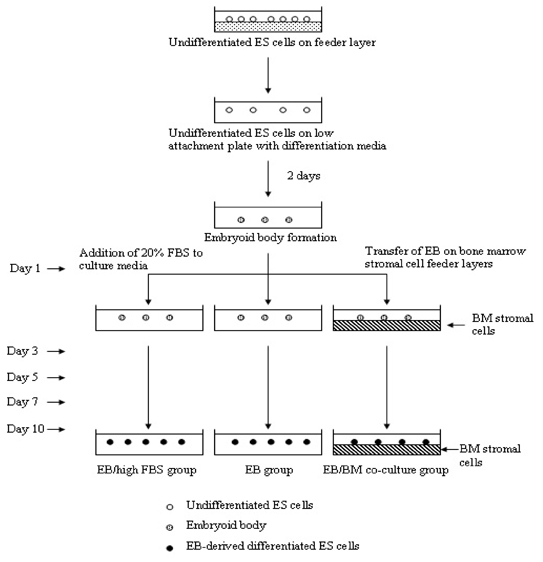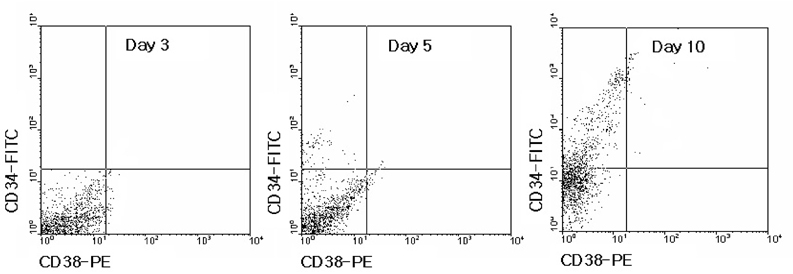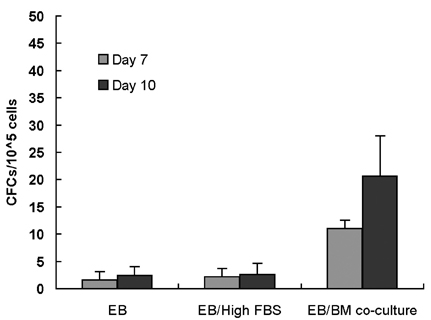Yonsei Med J.
2005 Oct;46(5):693-699. 10.3349/ymj.2005.46.5.693.
Hematopoietic Differentiation of Embryoid Bodies Derived from the Human Embryonic Stem Cell Line SNUhES3 in Co-culture with Human Bone Marrow Stromal Cells
- Affiliations
-
- 1Department of Internal Medicine, Korea University Medical Center, Seoul, Korea. kbs0309@korea.ac.kr
- 2Institute of Korea University Stem Cell Research, Korea University Medical Center, Seoul, Korea.
- 3Department of Laboratory Medicine, Korea University Medical Center, Seoul, Korea.
- KMID: 2158151
- DOI: http://doi.org/10.3349/ymj.2005.46.5.693
Abstract
- Human embryonic stem (ES) cells can be induced to differentiate into hematopoietic precursor cells via two methods: the formation of embryoid bodies (EBs) and co-culture with mouse bone marrow (BM) stromal cells. In this study, the above two methods have been combined by co-culture of human ES-cell-derived EBs with human BM stromal cells. The efficacy of this method was compared with that using EB formation alone. The undifferentiated human ES cell line SNUhES3 was allowed to form EBs for two days, then EBs were induced to differentiate in the presence of a different serum concentration (EB and EB/high FBS group), or co- cultured with human BM stromal cells (EB/BM co-culture group). Flow cytometry and hematopoietic colony-forming assays were used to assess hematopoietic differentiation in the three groups. While no significant increase of CD34+/CD45- or CD34+/CD38- cells was noted in the three groups on days 3 and 5, the percentage of CD34+/CD45- cells and CD34+/ CD38- cells was significantly higher in the EB/BM co-culture group than in the EB and EB/high FBS groups on day 10. The number of colony-forming cells (CFCs) was increased in the EB/BM co-culture group on days 7 and 10, implying a possible role for human BM stromal cells in supporting hematopoietic differentiation from human ES cell-derived EBs. These results demonstrate that co-culture of human ES-cell-derived EBs with human BM stromal cells might lead to more efficient hematopoietic differentiation from human ES cells cultured alone. Further study is warranted to evaluate the underlying mechanism.
Keyword
MeSH Terms
Figure
Reference
-
1. Thomson JA, Itskovitz-Eldor J, Shapiro SS, Waknitz MA, Swiergiel JJ, Marshall VS, et al. Embryonic stem cell lines derived from human blastocysts. Science. 1998. 282:1145–1147.2. Porada GA, Porada C, Zanjani ED. The fetal sheep: a unique model system for assessing the full differentiative potential of human stem cells. Yonsei Med J. 2004. 45:7–14.3. Reubinoff BE, Pera MF, Fong CY, Trounson A, Bongso A. Embryonic stem cell lines from human blastocysts: somatic differentiation in vitro. Nat Biotechnol. 2000. 18:399–404.4. Amit M, Carpenter MK, Inokuma MS, Chiu CP, Harris CP, Waknitz MA, et al. Clonally derived human embryonic stem cell lines maintain pluripotency and proliferative potential for prolonged periods of culture. Dev Biol. 2000. 227:271–278.5. Suh H. Tissue restoration, tissue engineering and regenerative medicine. Yonsei Med J. 2000. 41:681–684.6. Blume KG, Beutler E, Bross KJ, Chillar RK, Ellington OB, Fahey JL, et al. Bone-marrow ablation and allogeneic marrow transplantation in acute leukemia. N Engl J Med. 1980. 302:1041–1046.7. Appelbaum FR, Herzig GP, Ziegler JL, Graw RG, Levine AS, Deisseroth AB. Successful engraftment of cryopreserved autologous bone marrow in patients with malignant lymphoma. Blood. 1978. 52:85–95.8. Korbling M, Anderlini P. Peripheral blood stem cell versus bone marrow allotransplantation: does the source of hematopoietic stem cells matter? Blood. 2001. 98:2900–2908.9. Wiles MV. Embryonic stem cell differentiation in vitro. Methods Enzymol. 1993. 225:900–918.10. Nakano T, Kodama H, Honjo T. Generation of lymphohematopoietic cells from embryonic stem cells in culture. Science. 1994. 265:1098–1101.11. Xu C, Inokuma MS, Denham J, Golds K, Kundu P, Gold JD, et al. Feeder-free growth of undifferentiated human embryonic stem cells. Nat Biotechnol. 2001. 19:971–974.12. Itskovitz-Eldor J, Schuldiner M, Karsenti D, Eden A, Yanuka O, Amit M, et al. Differentiation of human embryonic stem cells into embryoid bodies compromising the three embryonic germ layers. Mol Med. 2000. 6:88–95.13. Levenberg S, Golub JS, Amit M, Itskovitz-Eldor J, Langer R. Endothelial cells derived from human embryonic stem cells. Proc Natl Acad Sci USA. 2002. 99:4391–4396.14. Schuldiner M, Yanuka O, Itskovitz-Eldor J, Melton DA, Benvenisty N. Effects of eight growth factors on the differentiation of cells derived from human embryonic stem cells. Proc Natl Acad Sci USA. 2000. 97:11307–11312.15. Chadwick K, Wang L, Li L, Menendez P, Murdoch B, Rouleau A, et al. Cytokines and BMP-4 promote hematopoietic differentiation of human embryonic stem cells. Blood. 2003. 102:906–915.16. Cerdan C, Rouleau A, Bhatia M. VEGF-A165 augments erythropoietic development from human embryonic stem cells. Blood. 2004. 103:2504–2512.17. Nakano T. In vitro development of hematopoietic system from mouse embryonic stem cells: a new approach for embryonic hematopoiesis. Int J Hematol. 1996. 65:1–8.18. Kim SJ, Kim BS, Ryu SW, Sung HJ, Park KH, Choi IK, et al. Differentiation culture of hematopoietic stem cells from embryonic stem cells. Korean J Hematol. 2004. 39:78–85.19. Wang L, Li L, Shojaei F, Levac K, Cerdan C, Menendez P, et al. Endothelial and hematopoietic cell fate of human embryonic stem cells originates from primitive endothelium with hemangioblastic properties. Immunity. 2004. 21:31–41.20. Oh SK, Kim HS, Ahn HJ, Seol HW, Kim YY, Park YB, et al. Derivation and characterization of new human embryonic stem cell lines: SNUhES1, SNUhES2, and SNUhES3. Stem Cells. 2005. 23:211–219.21. Park JC, Park BJ, Suh H, Park BY, Rah DK. Comparative study on motility of the cultured fetal and neonatal dermal fibroblasts in extracellular matrix. Yonsei Med J. 2001. 42:587–594.22. Kyba M, Perlingeiro RC, Daley GQ. HoxB4 confers definitive lymphoid-myeloid engraftment potential on embryonic stem cell and yolk sac hematopoietic progenitors. Cell. 2002. 109:29–37.23. Liu L, DiGirolamo CM, Navarro PA, Blasco MA, Keefe DL. Telomerase deficiency impairs differentiation of mesenchymal stem cells. Exp Cell Res. 2004. 294:1–8.24. Cho SK, Webber TD, Carlyle JR, Nakano T, Lewis SM, Zuniga-Pflucker JC. Functional characterization of B lymphocytes generated in vitro from embryonic stem cells. Proc Natl Acad Sci USA. 1999. 96:9797–9802.25. Kaufman DS, Thomson JA. Human ES cells--haematopoiesis and transplantation strategies. J Anat. 2002. 200:243–248.26. Kaufman DS, Hanson ET, Lewis RL, Auerbach R, Thomson JA. Hematopoietic colony-forming cells derived from human embryonic stem cells. Proc Natl Acad Sci USA. 2001. 98:10716–10721.
- Full Text Links
- Actions
-
Cited
- CITED
-
- Close
- Share
- Similar articles
-
- Assessment of Developmental Toxicants using Human Embryonic Stem Cells
- The effect of growth factors on osteogenic differentiation of adipose tissue-derived stromal cells
- Comparison of Human Bone Marrow Stromal Cells with Fibroblasts in Cell Proliferation and Collagen Synthesis
- The effects of BMP4 and BMP2 on Expression of Trophoblast-Specific Genes in Human Embryonic Stem Cells using SNU-hES3 cell line
- Manipulation of Human Telomerase Activity in Cancer and Stem Cells: Application of siRNA-induced Inhibition of Human Telomerase RNA (hTR)





